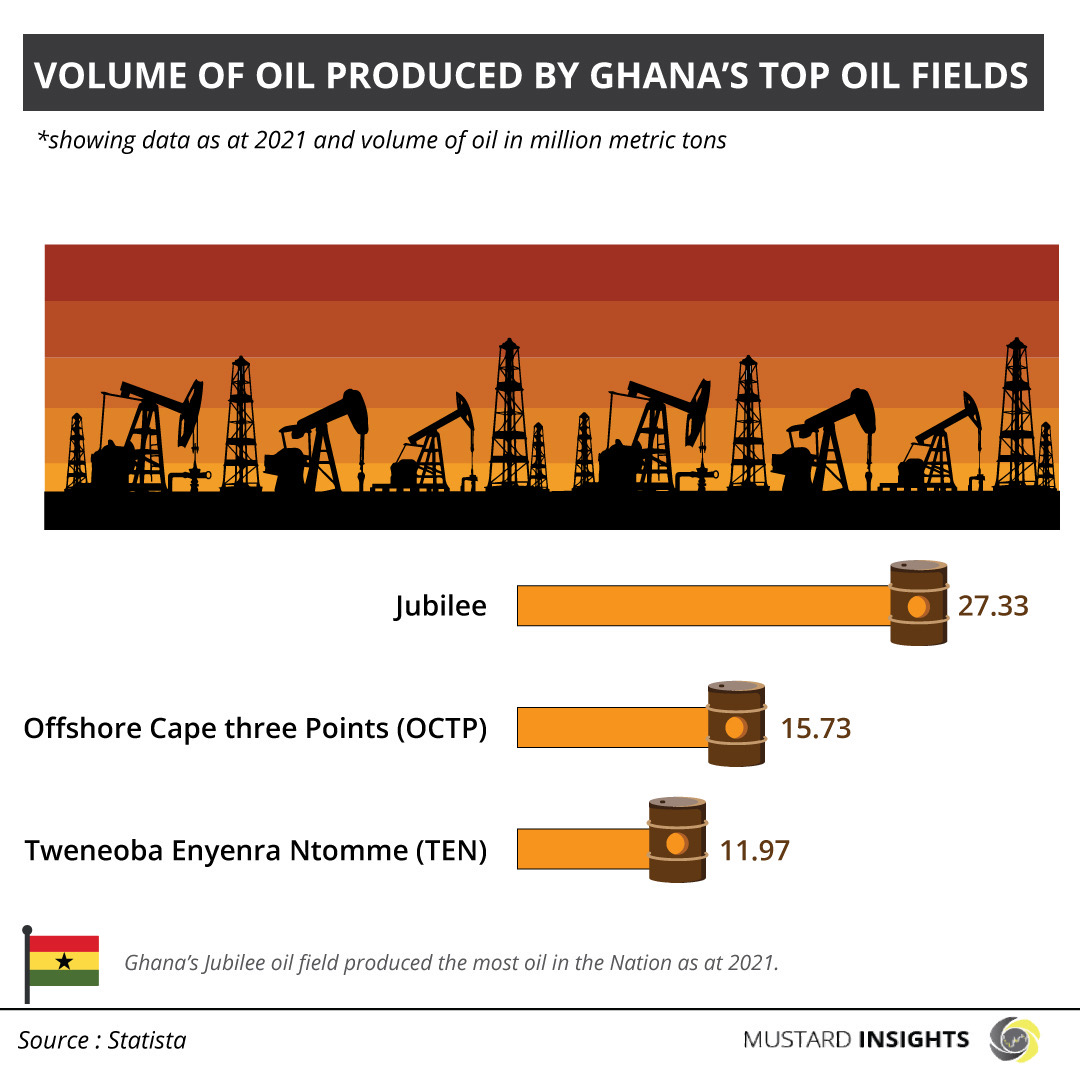Ghana’s Jubilee Oil Field keeps its position as Ghana’s top oil producing field despite a decline in the annual volume of oil produced in the country.
Crude oil has proven essential for the development of many nations around the world and the lifeblood of industrialized nations. Since the mid-1950s, oil has become the world’s most important source of energy. Its many products underpin modern society, supplying energy to the power industry, provide fuel for vehicles and aeroplanes to carry goods and people all over the world. Also, it provides the base of industrial advancement, contributes to a nation’s GDP and helps provide jobs to millions.
Ghana is a small oil and natural gas producer in West Africa and exports its crude oil production to international markets. The country’s natural gas production is used to fuel its domestic power plants. Ghana has always relied on biomass and waste, particularly firewood and charcoal. However, the share of biomass in Ghana’s energy mix has been declining because of increasing fossil fuel consumption.
Breakdown and Key Metrics
Data gotten from Statista for Ghana’s crude oil production in 2021 show that the country’s top oil fields produced a total volume of 55.03 million metric tonnes. The Jubilee field was the leading oil field in Ghana in terms of output. It produced approximately 27.3 million barrels of oil; accounting for about 49.7% of total annual oil production in the country.
As of 2018, Ghana’s Jubilee oil field produced 10.1 million metric tonnes of crude oil. Crude oil production from the field almost tripled in 2019 as the volume of oil produced peaked at 32.6 million metric tonnes. By 2020, crude oil production from the field had decreased to 30.4 million metric tonnes and decreased further to its 2021 volume of 27.3 million metric tonnes.
The Offshore Cape Three Points (OCTP) field - comprising the Sankofa and Gye Nyame production fields, is 2nd with a generated oil volume of around 15.7 million metric tonnes. This decreased from 2020 oil production, which had achieved a peak of 18.7 million metric tonnes. The OCTP’s oil generation in 2018 and 2019 were 10.1 million metric tonnes and 17.2 million metric tonnes, respectively.
The Tweneboa Enyenra Ntomme (TEN) oil ranked 3rd with an output of 11.97 million metric tonnes. This is a notable drop from the over 17.8 million barrels registered in the previous year. Between 2018 and 2021, TEN’s crude oil production gradually plummeted. In 2018, TEN’s crude oil production was 23.5 million metric tonnes and decreased to 22.3 million metric tonnes in 2019, 17.8 million metric tonnes in 2020.
Other Insight
As of October 2021, the crude oil production capacity in Ghana was 174, 000 barrels per day, considerably lower than the volume of crude oil produced in October 2020, when the country’s capacity reached 194,000 barrels per day. Since March 2020, the volume of crude oil produced in Ghana has followed a downward trend. However, oil production in the country reached an average of 173,000 barrels per day in 2020.
Decreasing oil revenue
In January 2021, Ghana’s revenue from crude oil accounted for 0.1% of the country’s Gross Domestic Product (GDP). By May 2021, crude oil revenue contribution to its GDP it had decreased to 0% before bouncing back to 0.1%. In real oil monetary inflow, Ghana accumulated around 512.7 million GHS (83 million USD) in January, while in May and June 2021, roughly no value and 620 million GHS (100.4 million USD), respectively.
Oil trade and prices
From oil export transactions made between entities in Ghana and the rest of the world, Ghana generated 836.2 million USD in the first quarter of 2021. The Balance of Payments on oil exports had stood at 784.6 million USD in the third quarter of the previous year. In June 2021, Ghana imported no crude oil into the country, with prices of crude oil reaching 73.35 USD per barrel.
Takeaway
Ghana’s petroleum sector has experienced significant growth, particularly since the discovery of oil in commercial quantities in the Jubilee, OCTP, and TEN oil fields. Average crude oil production capacity has been declining slightly over time, with an average of 176,000 barrels per day in 2021.
With major oil and gas activities in the country conducted by international oil companies, it remains to be seen whether the expectations for job creation within the petroleum industry is achievable. Also, the Ghanaian government needs to do more to make sure that revenue generated from the oil fields is best used for economic growth and development, and improving the quality of lives of the people of Ghana.
Thoughts?
We won't share your email address. All fields are required.

